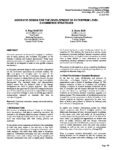
|
Axiomatic Design for the Development of Enterprise Level E-Commerce Strategies
Martin, S. B., Kar, A. K.
2nd International Conference on Axiomatic Design, 2002
Electronic commerce is dramatically changing the traditional way of doing business and moreover, the growth of the Internet is creating new business opportunities. Today many products, processes and organizations are complex systems that have to be designed in order to meet specific customer requirements.
|
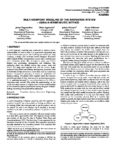
|
Multi-Viewpoint Modeling of the Innovation System – Using a Hermeneutic Method
Fagerström, J., Aganovic, D., Nielsen, J., Falkman, P.
2nd International Conference on Axiomatic Design, 2002
A multi-viewpoint modeling was conducted to obtain a better understanding of how to work in a concurrent engineering way within an innovation system. The modeling was carried out using a process-, a design- and a function centric viewpoint. The process centric viewpoint divides the innovation process into a development and a realization phase. The development phase was further divided into preparation, development and validation. The realization phase was divided further into source, make and deliver. The design centric viewpoint dealt with the iterative design processes both within and between development processes, from an Axiomatic Design perspective. It also dealt with the connection between development processes in terms of constraints and decision-making. The function centric viewpoint stated the functions and different kinds of flow that occurs in an innovation process. In the multi-viewpoint model the connections between the different viewpoints were stressed. This raised the understanding, of the whole innovation system, to a higher level. A better understanding of the innovation system provides the means for good decision-making concerning both productivity and quality.
|
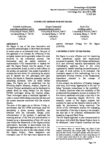
|
Axiomatic Design For Six Sigma
Arcidiacono, G., Campatelli, G., Citti, P.
2nd International Conference on Axiomatic Design, 2002
Six Sigma is one of the most innovative and successful methodologies to have been introduced in recent years at an industrial level. The goal of this approach is to increase the efficiency of the company system and to generally reduce the costs involved in the production process. The instruments used are mainly statistical: a representative CTQ characteristic is studied for each Six Sigma Project, and the causes of any non-conformities found, as well as their effects on the system, are analysed. This makes it possible to evaluate the best choice for optimising the system and to identify the risk associated with each choice; Six Sigma is, therefore, generally used for optimising processes. After an initial Define phase, Six Sigma can be subdivided into the following phases: Measure, Analyze, Improve & Control. Product optimisation can be developed in greater detail by using Design For Six Sigma (DFSS) techniques during the Improve phase. These techniques adopt a statistical approach in order to assess which design solutions are best and the system response associated with the solution chosen.
|
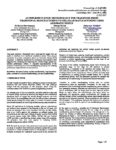
|
An Implementation Methodology for Transition from Traditional Manufacturing to Cellular Manufacturing Using Axiomatic Design
Durmusoglu, M. B., Kulak, O., Tufekci, S.
2nd International Conference on Axiomatic Design, 2002
This paper provides a framework and a road map for people who are ready to transform their traditional production system from process orientation to cellular orientation, based on Axiomatic Design (AD) principles. A feedback mechanism for continuous improvement is also suggested for evaluating and improving the cellular design against preselected performance criteria. A complete implementation of the proposed methodology at a local manufacturing company and resulting performance improvements are also provided.
|
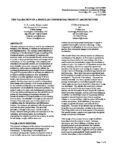
|
The Validation of a Modular Commercial Product Architecture
Lentz, V. A., Lerner, B., Whitcomb, C.
2nd International Conference on Axiomatic Design, 2002
This paper addresses the process used by one commercial company, Otis Elevator, to validate the architecture of a new flagship product. The existing commercial product architecture is loosely derived through a coupling of the functional domain, as envisioned by corporate and customer needs, and the physical domain, which evolves over time to keep up with innovation and changes in the marketplace. As new technology is investigated, and sometimes subsequently inserted, the occasion arises to more formally reassess the structure of he functional architecture, with a need to continually validate the evolving physical architecture in light of new technology. The goal of the current effort in architecture validation is to create a modular architecture with standardized interfaces to enable significant decreases in time to market, and reduction in the cost of production and support. Modules must meet the need for independence from change with coherence of the system architecture. As the modules and interfaces are standardized, ‘standard requirements’ are available for reuse acress products. The method employed to gain understanding and consistency of the new product architecture was the establishment of criteria for determining the boundaries between the functional entities and physical entities and the mapping between them. The principals of design, as advocated by Professor Nam Suh, were used to drive decisions by weighting using the Independence and Information Axioms. The methods and approach will subsequently be used with other product lines. The use of the principles of design is discussed, with the business drivers, related to taking the time and resources to do the validation, and business plans, for evolving the engineering and operations within the company to realize the advantages sought, will be addressed.
|
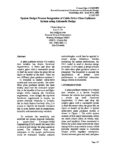
|
System Design Process Integration of Cable-Drive Glass Guiidance System using Axiomatic Design
Lin, C. L., Im, K. H.
2nd International Conference on Axiomatic Design, 2002
A glass guidance system of a vehicle door window has simple functional requirements: 1) Raise and drop the window glass with a reasonable speed, 2) Stall the motor when the glass hits an object or header of the door. There are two different glass guidance systems [1 – 4] available in market: cable-drive system and cross arm system. The cable-drive glass guidance system has been widely used over the cross-arm system due to the benefits of low-cost and light-weight while meeting the functional requirement. Even though the top-level functional requirement is simple, the system physical hierarchy is complex due to many factors involved. Also, it is crucial to identify the transfer functions due to noise factors such as temperature, humidity and manufacturing variation.
|
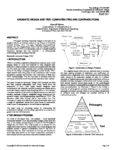
|
Axiomatic Design and TRIZ: Compatibilities and Contradictions
Mann, D.
2nd International Conference on Axiomatic Design, 2002
The paper examines Axiomatic Design in the light of its possible links to an evolved version of the Theory of Inventive Problem Solving, TRIZ. The paper highlights incompatibilities between the the Independence Axiom and the Ideality concept contained within TRIZ, but also several areas of mutually beneficial integration between the two methods – at philosophical, methodological and working tool levels.
|
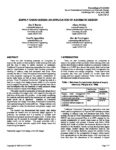
|
Supply Chain Design: An Application of Axiomatic Design
Baxter, J. E., Agouridas, V., McKay, A., de Pennington, A.
2nd International Conference on Axiomatic Design, 2002
There are ever increasing pressures on companies to improve the quality of their products whilst reducing both costs and the time it takes to deliver products to customers.Traditional Concurrent Engineering approaches have been widely used by organizations to improve their business processes -resulting in reduced costs and shortened lead times. More recently, the idea of Three Dimensional Concurrent Engineering has been proposed: arguing for the parallel consideration of supply chain issues as well as those related to product and process. Three Dimensional Concurrent Engineering leads to a need for a supply chain design process which, in turn, requires tools to support the process. The research reported here was an early investigation into the feasibility of using axiomatic design theory to support a supply chain design process.
|
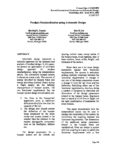
|
Product Standardization using Axiomatic Design
Nayak, R. U., Im, K. H.
2nd International Conference on Axiomatic Design, 2002
Axiomatic design represents a scientific approach for the synthesis and analysis of product design. In this paper, we present an application of axiomatic design approach for product standardization, using the independence axiom. The automotive bumper system is chosen as a case study. The amount of energy absorbed by bumper beam and energy absorbing material (foam) during a 5mph impact are the defining characteristics of bumper system. The two functional requirements that the bumper system design should satisfy are: 1. The force at the bumper/rail attachment point at maximum deflection should be less than the capacity of the rail. 2. The design also should restrict the deflection of the bumper beam (measured by the beam stroke and system stroke) to be smaller than the distance to the nearest damageable component such as the headlights, radiator etc. The design parameters for a bumper system are the vehicle rail spacing, vehicle mass, sweep radius of the bumper beam, beam material, type of beam section, beam width, height, and thickness of the section.
|
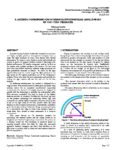
|
A Decision Framework for Integrated Synchronized Development of High Tech Products
Sahlin, M.
2nd International Conference on Axiomatic Design, 2002
In a fast moving business world with constraint in resources and highly complex products development managers have to make the right decisions in short time frames with limited information. To improve these decision tools and methods are needed to guide and support decision-makers in this tough time limited environment. To survive companies need to be first on the market with excellent products and services. On the other hand they have limited resources, complex design problems and high profitability demands to handle. To focus on the right opportunities tools are needed to get the right solutions in the right order for the highest profitability out of the development projects. Those who have the best competence and methods for making the right choices will take the lead and do the best business.
|
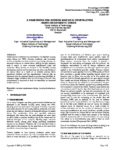
|
A Framework for Decision Making in Construction – Based on Axiomatic Design
Sohlenius, U., Johansson, C.
2nd International Conference on Axiomatic Design, 2002
Governmental interference has decreased in the Sweedish housing sector during the 1990s. Housing producers and customers, lenders, authorities, and other actors are now facing a situation of increased influence of market forces. Making the right decisions early is crucial to meet customer requirements today and tomorrow. Many parties are involved in the Sweedish housing development process and the lead times are often long. Decisions are usually taken as a result of an iterative process where experience, intuition and the organizational structure play an important role. An approach based on fundamental principles of axiomatic design combined with the LOLA rule LOw and LAte commitment) is proposed as basis for describing an improved decision process.
|
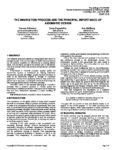
|
The Innovation Process and the Principal Importance of Axiomatic Design
Sohlenius, G., Fagerström, J., Kjellberg, A.
2nd International Conference on Axiomatic Design, 2002
The industrial production system is a living system that has to be managed by mean. It is our main engine of wealth where productive use of machines amplifies our effectiveness in meeting defined needs. The innovation process is the dynamic part of this system. This is the process where new products and production processes are created. Effectiveness in industrial processes requires quality and productivity. Quality is understood as meeting customers’ requirements, surprise and delight. Quality requires innovation in order to be dynamically adapted to changes in customers’ expectations. Productivity is expressing ability to meet quality with optimal use of resources. To strengthen industrial effectiveness we need a strong scientific base for innovation processes. Axiomatic criteria in the decisions belonging to innovation processes have a powerful potential to increase quality and productivity in industrial production. This paper aims at explaining why and how, furthermore addresses it a strict handling of competence.
|
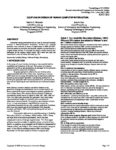
|
Coupling In Design of Human Computer Interaction
Helander, M. G., Jiao, J.
2nd International Conference on Axiomatic Design, 2002
Axiomatic design procedures may be used to decouple usability analyses in Human-Computer Interaction. Nielsen’s ten usability heuristics were analyzed in terms of implications for FRS and DP’s. From the results we conclude that heuristic usability analysis leads to a coupled design process. To uncouple the design a cluster analysis was performed on the original design matrix. FR’s were then split and recombined in order to reduce the coupling.
|
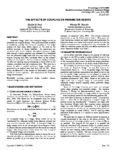
|
The Effects of Coupling on Parameter Design
Frey, D. D., Hirschi, N. W.
2nd International Conference on Axiomatic Design, 2002
Axiomatic Design holds that uncoupled designs are to be preferred over coupled designs. This paper documents an effort to empirically quantify the effects of coupling on the design process and how those effects depend on the scale of the problem (number of design variables). An experiment was conducted with human subjects who solved parameter design tasks through a simple user interface. It is established that, for parameter design tasks with only two inputs and two outputs, coupling had only a moderate effect on the subjects’ solution of the problem. As the number of variables increases, the effect of coupling amoung variables has a drastic effect on the solution procedures and the completion time. The time for a human to solve a coupled parameter design problem rises geometrically as problem size rises from 2X2 to 5X5. These results are discussed in the context of infomation processing models of human cognition. The implications for Axiomatic Design are discussed.
|
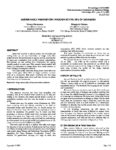
|
Design Fault Prevention Through Active Use of Database
Hatamura, Y., Nakao, M., Iino, K.
2nd International Conference on Axiomatic Design, 2002
Japan has launched a national project for collecting and making active use of case information of design faults. The project involves the government, its agents, schools, and industry of Japan and cooperation from several overseas organizations. The process not just collects fault information but applies scenario analysis to each case. The scenario based analysis will clarify, the mechanism of design faults, from small mistakes to those leading to catastrophic accidents. Our early case studies show that design faults occur when the design matrix [Suh, 1990, 2001] or design constraint contains error or is incomplete. This paper introduces our first stage studies of how design faults occur and how we plan to reduce their frequency and seriousness.
|
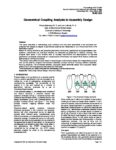
|
Geometrical Coupling Analysis in Assembly Design
Söderberg, R., Lindkvist, R.
2nd International Conference on Axiomatic Design, 2002
This paper describes a methodology and a software tool that allow assemblies to be evaluated and analyzed with respect to degree of geometrical coupling and robustness on any hierarchical level of the assembly structure. Based on mating conditions and specified geometrical constraints, geometrical couplings between sub-systems, components and individual features are detected and presented in stability matrices. The analysis tools assist in the iterative work of concept improvement and decomposition of top-level geometrical constraints (tolerances on critical product dimensions) into bottom level feature constraints (tolerances on individual surfaces). The analysis tools utilize the basic ideas in robust design and axiomatic design (the independence axiom) and can be used to compare and evaluate assembly concept solutions including different assembly fixturing solutions. The similarities between uncoupled robust assembly design and uncoupled robust tolerancing of individual parts are discussed and illustrated. Three examples are used to describe the methodology and the software tool.
|
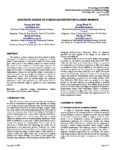
|
Axiomatic Design of a Beam Adjuster for a Laser Marker
Shin, G. S., Yi, J. W., Kang, B. S., Park, G. J.
2nd International Conference on Axiomatic Design, 2002
The usage of a beam scanning type laser marker is rapidly increasing in the field of semiconductor equipment. A device called a “beam adjuster” is employed to adjust the visible diode laser, which points to the marketing position for various settings. The device is very sensitive to manufacturing tolerances and assembling conditions. The axiomatic approach is applied to the design of the device. An existing design is analysed based on the Independence Axiom, but the existing design is discovered to violate the axiom. Two new designs are proposed to satisfy the Independence Axiom. The Information Axiom is utilized to evaluate the designs, and the selected design has minimum information content. The significance of this research is that a full cycle of axiomatic design is applied to a real engineering product.
|
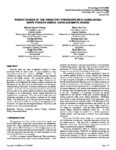
|
Robust Design of the Vibratory Gyroscope with Unbalanced Inner Torsion Gimbal Using Axiomatic Design
Hwang, K. H., Lee, K. H., Park, G. J., Lee, B. L., Cho, Y. C., Lee, S. H.
2nd International Conference on Axiomatic Design, 2002
Recently, there has been considerable interest in micro gyroscopes made of silicon chips. It can be applied to many micro-electro-mechanical systems (MEMS): devices for stabilization, general rate control, directional pointing, autopilot systems, and missile control. The mechanical design of the gyroscope is carried out using axiomatic design, followed by the application of the Taguchi robust design method to determine the dimensions of the parts so as to accommodate the dimensional variations during fabrication. Functional requirements are defined twofold. One is the natural frequencies should have fixed values, and the other is the system should be robust to large tolerances. According to the Independence Axiom, design parameters are classified into a few groups. Then, the detailed design process is performed according to the sequence indicated by the design matrix. The dimensions of the structure are determined to have constant values for the difference of frequencies regardless of the tolerances. It is noted that the Taguchi concept is utilized as a unit process of the entire axiomatic approach.
|
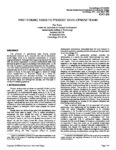
|
Partitioning Tasks to Product Development Teams
Braha, D.
2nd International Conference on Axiomatic Design, 2002
The principle of partitioning tasks among product development teams so as to minimize the cost of interactions across design teams is an important characteristic of complex engineered systems. Although there is growing literature that deals with the proper organization of product development tasks, little attention is given to rigorous modeling of the phenomena. To fill the void, we present a mathematical formulation for the problem. Two main issues are addressed by the model: 1) how to specify task dependencies, and 2) how to optimally partition the tasks among a number of teams. In this paper, we suggest to utilize the ‘design matrix’ representation of Axiomatic Design as a means for specifying tasks and their associated attributes. The developed model and solution technique can be applied to various scales of the product design and development process, and may open a variety of interesting questions.
|
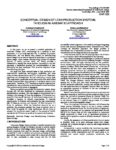
|
Conceptual Design of Lean Production Systems Through An Axiomatic Design Approach
Houshmand, M., Jamshidnezhad, B.
2nd International Conference on Axiomatic Design, 2002
In this paper, we are to present a practical application of Axiomatic Design (AD) methodology as a roadmap to lean production, in a car body assembly line. In addition to product development, AD has already been applied for manufacturing system design but we tend to expand its application to production system design, which besides manufacturing includes all activities required to satisfy customer needs. AD theory provides a framework to simplify the whole problem. According to the AD principles, a hierarchical structure for conceptualization of lean philosophy has been developed. This structure originates in lean manufacturing principles.
|
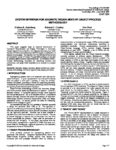
|
System Definition for Axiomatic Design Aided by Object-Process Methodology
oderborg, N., Crawley, E. F., Dori, D.
2nd International Conference on Axiomatic Design, 2002
This paper suggests ways to improve formulation of Functional Requirements and Design Parameters in Axiomatic Design based on the contention that adequate descriptions of both function (WHAT) and architecture (HOW) require a combination of objects and processes. We describe how the definitional framework and expressive power of Object-Process Methodology can be used to represent system function and architecture. We introduce Object-Process Methodology templates for describing function and architecture, and apply these templates as an example to a simple system.
|
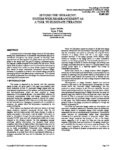
|
Beyond the Hierarchy: System-Wide Rearrangement as a Tool to Eliminate Iteration
Melvin, J., Suh, N. P.
2nd International Conference on Axiomatic Design, 2002
A primary tenet of axiomatic design theory is the first axiom, stating that independence of functional requirements should be maintained throughout the design process. As the high level requirements are decomposed into greater detail, and information added to the design with the goal of creating a realizable system, the designer creates subsystems that satisfy the first axiom. While higher level decisions imply an intent that should be maintained as detail is added, this is often not done. When a system is designed that results in some unintended interactions between design elements, it is possible to achieve a non-iterative design process by rearranging the leaf level elements as a collective set. This is shown for a subset of elements from the design of a chemical mechanical polishing (CMP) machine tool.
|
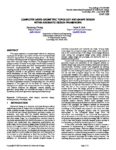
|
Computer Aided Geometric Topology and Shape Design Within Axiomatic Design Framework
Chung, J., Suh, N. P.
2nd International Conference on Axiomatic Design, 2002
This paper presents a computer-aided method for designing topologies and shapes of geometric artifacts from the highest-level functional requirements in conceptual design phase. The method combines a thinking process of engineering design and knowledge base within axiomatic design framework. The proposed thinking process is called a V-model in this paper. The V-model consists of three main sub-processes; top-down decomposition process of functional requirements(FRs) and design parameters(DPs), mapping process of DPs into geometric entities, and bottom-up integration process of the geometric entities. Knowledge base stores information on FRs, DPs, and corresponding geometric entities generated during the V-model design process in a unique structure designed to combine advantages of both top-down and bottom-up approaches. The design matrix is used to relate visually the effect of geometric entities to corresponding FRs. The method presented in this paper can be the basis for creating a new intelligent CAD system that incorporates the FRs of a design task. This method enhances the designers’ creative thinking for geometric shape design and facilitates the reuse of CAD models by relating functions to geometric topology and shape design.
|
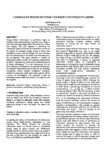
|
F-Granular Design Information Based Information Axiom
Ullah, U.
2nd International Conference on Axiomatic Design, 2002
Design-relevant information is sometimes vague or linguistic (technically speaking, f-granular) (e.g., design a slim shaft with light weight where dimensions are critical than weight). This puts obstacle in practicing the information axiom (minimize the information content ofthe design) of axiomatic design theory, a theory that establishes a science base for design. In such a situation,how one should practice the axiom is an important issuefor investigation. This paper proposes a version ofinformation axiom, suitable for f-granular information,as follow: “maximize the coherency (overall definiteness)of design information.” It is the consequence of twolinear measures of definiteness of f-granular information.As axiomatic design farther moves into the age of design automation, various machine intelligence techniques capable of computing words rather than numbers will be a matter of investigation. The proposed version of information axiom might help achieve the goals of such investigation.
|